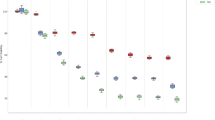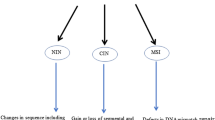Abstract
It was recently reported that arsenic trioxide (As2O3) can induce complete remission in patients with acute promyelocytic leukemia (APL). In this present article, the biological effect of (As2O3) on human cervical cancer HeLa cells and HeLa cells overexpressing Bcl-2 is studied. By MTT and colony forming ability assays, morphology alteration, flow cytometric analysis, DNA gel electrophoresis andin situ cell death detection (TUNEL), it was found that As2O3 inhibited the growth of HeLa cells and induced G2/M arrest and apoptosis of the cells. RT-PCR, Northern blot, Western blot analysis revealed that As2O3 induced HeLa cell apoptosis possibly via decreasing the expression of c-myc and viral genes. HeLa cells overexpressing Bcl-2 partly resist As2O3 induced apoptosis, which might be relative to preventing the cells from As2O3 caused G2/M block, downregulation of c-myc gene expression and inhibition of viral gene expression was also noted. However, it was found that As2O3 at a high concentration could also induce apoptosis of HeLa cells overexpressing Bcl-2 possibly mainly via downregulating Bcl-2 expression and slightly inhibiting viral gene expression.
Similar content being viewed by others
References
Sun, H. D., Ma, L., Hu, X. C. et al., Treatment of acute promyelocytic leukemia (32 cases) with intravenous arsenic triox-ide,Chin. J. Integr. Chin. West Med., 1992, 12: 170.
Zhang, P., Wang, S.Y., Hu, L.H. et al., Treatment of acute promyeliocytic leukemia (72 cases) with intravenous arsenic trioxide,Chin. J. Hematol., 1996, 17: 58.
Chen Guoqiang, Zhu Jun, Shi Xuegeng et al.,In vitro studies on cellular and molecular mechanisms of arsenic trioxide (As2O3) induces NB4 cell apoptosis with downregulation of bcl-2 expression and modulation of PML-RAR2/PML proteins,Blood, 1996, 88(3): 1052.
Parkin, D.M., Laara, E., Muir, C.S., Estimates of the worldwide frequency of sixteen major cancer in 1980,Int. J. Can-cer, 1988, 41: 184.
Reed, J.C., Bcl-2 and the regulation of programmed cell death,J. Cell Biol., 1994, 124: 1.
Fuhlbrigge, R. C., Fine, S. M., Unanue, E. R., Expression of membrane interleukin 1 by fibroblasts transfected with murine pro-interleukin lα cDNA,Proc. Natl. Acad. Sci. USA, 1988, 85: 5649.
Sambrook, J., Fritsch, E. F., Maniatis, T.,Molecular Cloning:A Laboratory Manual, New York: Cold Spring Harbor Lab-oratory Press, 1989, 970–974.
Vistica, D. T., Skehan, P., Scudiero D., Tetrazolium-based assays for cellular viability: a critical examination of selected parameters affecting formazan production,Cancer Res., 1991, 51: 2515.
Li, X. T., Lin, C., Li, P. Y. et al., The sensitivity of human gastric adenocarcinoma MGC803 to drugs and the clinical im-plication,Chin. J. Onco., 1989, 11(5): 332.
Nicoletti, I., Migliorati, G., Pagliacci, M.C. et al., A rapid and simple method for measuring thymocyte apoptosis by pro-pidium iodide staining and flow cytometry,J. Immunol. Methods, 1991, 139: 271.
Hermann, M., Lorenz, H. M., Voll, R. et al., A rapid and simple method for the isolation of apoptotic DNA fragments,Nuclic. Acid Research, 1994, 22(24): 5506.
Allouche, M., Bettaib, A., Vindis, C. et al., Influence of Bcl-2 overexpression on the ceramide pathway in daunorubin in-duced apoptosis of leukemic cells,Oncogene, 1997, 14: 1837.
Kondo, S., Yin, D.L., Morimura, T. et al., Transfection with a bcl-2 expression vector protects transplanted bone marrow from chemotherapy induced myelosuppression,Cancer Res., 1994, 54: 2928.
Dwmarcq, C., Bunch, R.T., Creswell, D. et al., The role of cell cycle progression in cisplatin-induced apoptosis in Chinese hamster ovary cells,Cell Growth Differ., 1994, 5: 983.
Kangas, A., Nicholson, D. W., Holtta, E., Involvement of CPP32/caspase-3 in c-myc induced apoptosis,Oncogene, 1998, 16: 387.
Lock, R.B., Thompson, B.S., Sullivan, D.M. et al., Potentiation of etoposide induced apoptosis by staurosporine in human tumor cells is associated with events downstream of DNA-protein complex formation,Cancer Chemother. Pharmacol., 1997, 39(5): 399.
Magal, S. S., Jackman, A., Pei, X. F. et al., Induction of apoptosis in human keratinocytes containing mutated p53 alleles and inhibition by both the E6 and E7 oncoproteins,Int. J. Cancer, 1998, 75: 96.
Author information
Authors and Affiliations
Rights and permissions
About this article
Cite this article
Deng, Y., Lin, C., Zheng, J. et al. Mechanisms of arsenic trioxide induced apoptosis of human cervical cancer HeLa cells and protection by Bcl-2. Sci. China Ser. C.-Life Sci. 42, 635–643 (1999). https://doi.org/10.1007/BF02881582
Received:
Issue Date:
DOI: https://doi.org/10.1007/BF02881582




